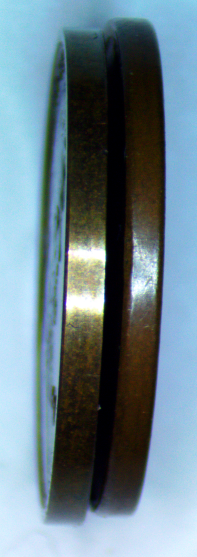Edge


These two top images are a comparison of the edges of a 1915 matte proof (left) next to a 1915 business strike (right) coin. At left they are pressed together. At right they are free standing.
The edge of a matte proof will always be flatter, smoother, and more reflective then its more rounded business strike counterpart. A matte proof will stand alone on its edge very easily. Further,
the inside and outside edges of the rim, as seen in the images below with the matte proof on the left and the business strike on the right in each image, will be sharper and crisper. A matte proof will have its
inside edge drop off more steeply and therefore the coin will exhibit less of an inside curved dish than a business strike. A matte proof may also have a slight fin on the far outside of the rim around the coin.

In general a matte proof coin will have the following surface and edge characteristics to help differentiate it from its business strike counterpart:
• More detail in the image and design elements.
• A surface matte appearance resulting from the blasting of the die surface. Wear and toning may result in this surface being lost.
• Flatter, smoother, and more reflective rims.
• Sharper and crisper edges on the outside and inside of the rim.
• Less dishing of the coin than for a business strike.

To be absolutely confident when authenticating a matte proof coin you must examine the die characteristics for that year as described below on the obverse and reverse for the 1915 matte proof.
Obverse

A single die set was used for all 1915 matte proofs. Here is a die scratch from the rim between IN and GOD.

A die scratch through the O of GOD.

A die scratch through the R and U in TRUST.

A die scratch below the RTY of LIBERTY.
Reverse

A thin die scratch from the top right of the T in CENT upwards.

A thin die scratch from the T of CENT angled down to the second S of STATES.

A thin die scratch from the R of AMERICA to the right wheat stalk.










